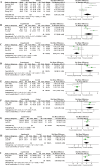Efficacy and Potential Mechanisms of Umbilical Cord-Derived Mesenchymal Stem Cells in the Treatment of Ischemic Stroke in Animal Models: A Meta-Analysis
- PMID: 40202099
- PMCID: PMC11979713
- DOI: 10.1111/cns.70357
Efficacy and Potential Mechanisms of Umbilical Cord-Derived Mesenchymal Stem Cells in the Treatment of Ischemic Stroke in Animal Models: A Meta-Analysis
Abstract
Background: Umbilical cord-derived mesenchymal stem cells (UCMSCs) have emerged as a promising treatment for ischemic stroke. This study aimed to evaluate the therapeutic efficacy and potential mechanisms of UCMSCs in treating ischemic stroke.
Methods: A systematic search of PubMed, Web of Science, and Embase was conducted up to April 25, 2024. Literature was screened based on the PICOS principle, with predefined inclusion and exclusion criteria. Relevant data were extracted and analyzed using Review Manager 5.4.
Results: Out of 1390 retrieved articles, 30 were included in the meta-analysis. UCMSCs significantly reduced infarct size and volume, improved neurological deficit scores, and facilitated neurobehavioral recovery. UCMSCs treatment also modulated inflammatory cytokine levels in brain tissue and serum, promoted microglial polarization, inhibited apoptosis, and increased vessel density in the peri-infarct tissue.
Conclusions: UCMSCs administration significantly promoted the neurological function recovery after ischemic stroke. Their mechanisms of action may be related to immune response regulation, inhibition of apoptosis, and promotion of angiogenesis. These findings provide theoretical guidance for improving the quality of basic research and clinical translation.
Keywords: animal study; ischemic stroke; meta‐analysis; umbilical cord‐derived mesenchymal stem cells.
© 2025 The Author(s). CNS Neuroscience & Therapeutics published by John Wiley & Sons Ltd.
Conflict of interest statement
The authors declare no conflicts of interest.
Figures









Similar articles
-
The Effect of Umbilical Cord Mesenchymal Stem Cells Combined with Tetramethylpyrazine Therapy on Ischemic Brain Injury: A Histological Study.J Stroke Cerebrovasc Dis. 2020 Dec;29(12):105298. doi: 10.1016/j.jstrokecerebrovasdis.2020.105298. Epub 2020 Sep 16. J Stroke Cerebrovasc Dis. 2020. PMID: 32992203
-
Efficacy and Mechanism of Highly Active Umbilical Cord Mesenchymal Stem Cells in the Treatment of Osteoporosis in Rats.Curr Stem Cell Res Ther. 2025;20(1):91-102. doi: 10.2174/011574888X284911240131100909. Curr Stem Cell Res Ther. 2025. PMID: 38357953
-
Therapeutic potential of mesenchymal stem cell-derived extracellular vesicles in ischemic stroke: A meta-analysis of preclinical studies.Brain Res Bull. 2025 Feb;221:111219. doi: 10.1016/j.brainresbull.2025.111219. Epub 2025 Jan 19. Brain Res Bull. 2025. PMID: 39837375
-
Bioactive molecules derived from umbilical cord mesenchymal stem cells.Acta Histochem. 2016 Oct;118(8):761-769. doi: 10.1016/j.acthis.2016.09.006. Epub 2016 Sep 28. Acta Histochem. 2016. PMID: 27692875 Review.
-
Stem cell-derived exosomes for ischemic stroke: a conventional and network meta-analysis based on animal models.Front Pharmacol. 2024 Oct 23;15:1481617. doi: 10.3389/fphar.2024.1481617. eCollection 2024. Front Pharmacol. 2024. PMID: 39508049 Free PMC article.
References
-
- Hilkens N. A., Casolla B., Leung T. W., et al., “Stroke,” Lancet 403, no. 10446 (2024): 2820–2836. - PubMed
-
- Maida C. D., Norrito R. L., Rizzica S., Mazzola M., Scarantino E. R., and Tuttolomondo A., “Molecular Pathogenesis of Ischemic and Hemorrhagic Strokes: Background and Therapeutic Approaches,” International Journal of Molecular Sciences 25, no. 12 (2024): 6297, 10.3390/ijms25126297. - DOI - PMC - PubMed
Publication types
MeSH terms
Grants and funding
- 82474616/the National Natural Science Foundation of China
- 2021JQ13/the 900TH hospital of Joint Logistics Support Force
- 2022QC04/the 900TH hospital of Joint Logistics Support Force
- 2021Y2017/Fujian Clinical Research Center for Aptamer-based Precision Testing
- 2023Y9267/the innovation of science and Technology, Fujian province
LinkOut - more resources
Full Text Sources
Medical
Miscellaneous

